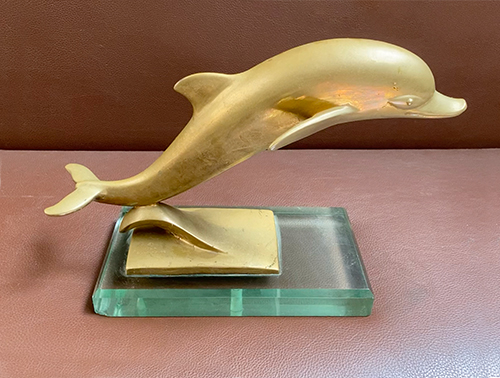
LF 270
"Leaping Dolphin," 1926
Bronze, gold patina,
Height: 9 inches, Length: 13 inches (dolphin snout to tail), Original glass base height: 1 1/2 inches
Private Collection, Massachusetts
“For grace of action and sense of power there are few living things comparable to the dolphin.”
(International Studio, August 1925, with an image of a dolphin fountain by Lachaise).
The leaping dolphin is an elegant design which Lachaise employed with great success between 1917 and 1931, yielding fountains and sculptures of one, three, four, five, and up to a dozen dolphins, as in the Whitney Museum of American Art’s Dolphin Fountain of 1924, purchased by Gertrude Vanderbilt Whitney sometime before the museum’s opening in 1931. He exhibited his dolphin sculptures at galleries (Bourgeois Galleries, 1918, Kraushaar Galleries, 1920s) and in exhibitions (the Art Institute of Chicago, 1925-26, and the Museum of Modern Art, New York, 1930-31).
The 1920s were successful years for Lachaise. He had had his first one-man exhibit (Bourgeois Galleries, NY, 1918), was doing business with Kraushaar Galleries and receiving important commissions—due in part to his work with Paul Manship. One was for the lobby of the AT&T building at 195 Broadway (Welles Bosworth, 1922), another for a bridge at Vizcaya, James Deering’s Miami mansion, commissioned by Paul Chalfin. These commissions, combined with portrait sculpture and radiator caps, helped pay the sculptor’s bills. From 1925 to 1933, Lachaise issued a few bronze casts of single dolphins, which functioned as fountains and radiator cap ornaments.
This single leaping dolphin of this work was inspired by one of the central dolphins at play in Lachaise’s earlier fountains. In Lachaise’s handwritten album entitled Reference to Sculpture and Drawings, 1928-1931 in the Beinecke Library at Yale University, there are two entries describing a solitary leaping dolphin. The first, dated June 1928, shows a leaping dolphin on a self-same rectangular base, drawn in ink with the note: “model of single dolphin plaster, plaster in studio, inlimited” [sic] one bronze cast sold to Meigs, two to Howe, cast as a fountain by R.B.W.”( p. 3). This first one is inscribed “G Lachaise ©1924.” The second entry shows a similar leaping dolphin from the other direction, on a self-same rectangular base drawn in ink with the note: “radiator cap Leaping Dolphin, sold entirely to Meigs, (p. 12). This second one is inscribed “G Lachaise ©1926.”
An ode to forward motion and grace, the leaping dolphin made a fitting hood ornament. Architects such as George Howe (1886-1955), Arthur Meigs (1882-1956) and Philip Goodwin (1885-1958) recognized this, commissioning numerous different works from Lachaise for their cars, including the leaping dolphin (also Eddie Warburg, LF 316). See below for an image of the hood ornament on Mr. Meigs’ Chrysler.
As a stand-alone sculpture, Leaping Dolphin is a testament to Lachaise’s skills of observation, simplification, and attention to finish. Furthermore, it attempts something greater than simple representation. Lachaise himself wrote, “on certain occasions I have made use of animals, sea-gulls, sea-lions, dolphins, peacocks, penguins, to translate spiritual forces.” (Gaston Lachaise, “A Comment on My Sculpture,” Creative Art, August 1928).
This Leaping Dolphin sculpture belonged to Lachaise’s lawyer, Mr. Gustave Garfield, Esq., a successful young attorney who had become acquainted with Lachaise in 1926 and proceeded to represent him on legal matters. According to Mr. Garfield’s great nephew, Mr. and Mrs. Garfield gave this dolphin as a wedding gift to his parents, Mr. and Mrs. Cecil Robert Gordon, who were married January 7, 1930. Bernice Gerstein, Mrs . C. R. Gordon, was a sister of Evelyn Gerstein, Mrs. Gustave Garfield.
Other examples of single dolphins include dolphins removed from the original wooden model for the artist’s largest fountain, the Whitney Fountain of 1924. One single dolphin taken from this model is in the collection of the Metropolitan Museum of Art, another in the collection of The Renee and Chaim Gross Foundation, New York.
— Text by Paula R. Hornbostel